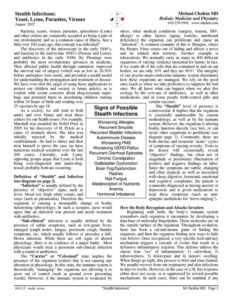Yeast (Candida), Mold, Fungus, Mushrooms
Updated February 13, 2024
Yeast syndrome, often called Candidiasis, is often caused by overgrowth of naturally-occurring yeast called Candida species. The condition is called a syndrome rather than infection because overgrowth or imbalance (dysbiosis) has several factors or root causes. These include: antibiotics, sugar, certain vaccines, diabetes, hormones (especially steroids and birth control) and other factors.
MoreHealing Stepping Stones
File Access
Yeasts that Affect Humans Sheet
click here
From Open AI
Yeast, mold, fungus and mushroom are all types of microorganisms that belong to the kingdom Fungi. However, each term refers to a different type or characteristic of fungi:
- Yeast: A type of single-celled fungi that can ferment sugars to produce carbon dioxide and alcohol.
- Mold: A type of fungi that grows in the form of multicellular filaments called hyphae and can form visible colonies on surfaces.
- Fungus: A broader term that encompasses all fungi, including yeast and mold.
- Mushroom: A type of fungi that forms a fruiting body above ground, which produces spores (spores) to spread and propagate
From Open AI
Here are examples of yeast, mold, fungus, and mushrooms, along with their presence in human food and body:
- Yeast: Saccharomyces cerevisiae (baker’s yeast), Candida (a type of yeast that can cause infections in humans). Yeast is used in the production of bread, beer, and wine.
- Mold: Penicillium (used in the production of blue cheese and penicillin), Aspergillus (can produce mycotoxins harmful to humans). Mold can be found on food items such as bread, fruit, and cheese.
- Rusts: Puccinia (a type of rust that affects crops such as wheat and barley). Rusts are plant pathogens and do not typically affect humans directly.
- Smuts: Ustilago (a type of smut that affects corn). Smuts are plant pathogens and do not typically affect humans directly.
- Fungi: Aspergillus, Candida, Dermatophytes (cause skin infections). Some fungi can be harmful to humans and cause infections, while others can be beneficial, such as those used in the production of fermented foods.
- Mushroom: Agaricus bisporus (white button mushroom), Pleurotus ostreatus (oyster mushroom). Mushrooms are edible and are commonly consumed as a food source.
Note: Some molds and fungi can cause infections in humans if they enter the body through the respiratory or digestive system. It’s important to properly store and prepare food to reduce the risk of exposure to harmful microorganisms.








